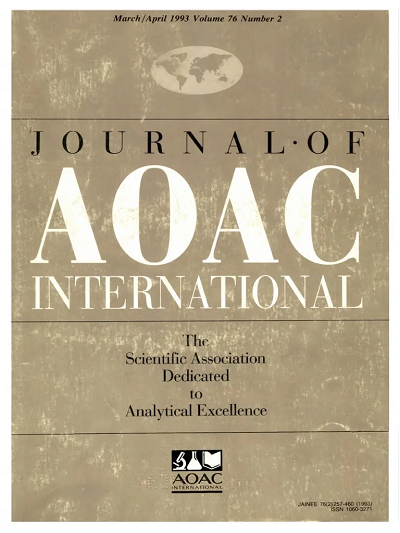Colorimetric Concurrent Determination of Ultra-Trace Amounts of Pilocarpine and Timolol as anti-Glaucoma Drugs in Binary Mixtures Using a Multivariate Calibration Approach Based on the Aggregation of Gold Nanoparticles
IF 1.7
4区 农林科学
Q3 CHEMISTRY, ANALYTICAL
引用次数: 0
Abstract
Background To study the ultra-trace simultaneous determination of drugs, the colorimetric method in combination with chemometrics can be used. Objective In this study, a simple, rapid, and sensitive UV-Vis spectrophotometric method using gold nanoparticles (AuNPs) was introduced for the simultaneous determination of ultra-trace amounts of Pilocarpine (PIL) and Timolol (TIM) in binary mixtures and biological sample. Methods AuNPs interacted with components and the aggregation mode of NPs occurred and finally, the color change of the solution (red to gray) was observed with the naked eye without the most modern and expensive instruments. The characterization of AuNPs was evaluated by transmission electron microscopy (TEM) and dynamic light scattering (DLS). Results The validation of the colorimetric way was studied in the concentration range of 100–800 and 100–600 μg/L with good linearity equal to 0.9772 and 0.9891 for PIL and TIM, respectively. The limit of detection (LOD) was found to be 165.00 and 92.40 μg/L, where the limit of quantitation (LOQ) was 500.00 and 280.00 μg/L for PIL and TIM, respectively. The effect of some factors such as interaction time, the concentration of components, and the volume of buffer on absorbance was investigated. Partial least squares (PLS) as an efficient multivariate calibration method was combined with colorimetry for the simultaneous determination of PIL and TIM in binary mixtures. The optimum number of latent variables was selected by k-fold cross-validation based on minimum mean square error prediction (MSEP) and the number of components equal to 1 with MSEP of 1.085 and 0.763 was considered for PIL and TIM, respectively. The mean recovery was obtained at 100.20% and 101.55% for PIL and TIM, respectively. Conclusion The colorimetric method can be introduced as a proper option for the simultaneous determination of components in pharmaceutical formulations and other samples. Highlights A colorimetric method using AuNPs was proposed. PLS method was coupled with a colorimetric method for the ultra-trace simultaneous estimation of PIL and TIM in binary mixtures. Ultra-trace amounts of PIL and TIM were also determined in biological sample. The proposed method is simple, fast and less expensive than chromatography methods.利用基于金纳米粒子聚合的多元校准法同时比色测定二元混合物中抗青光眼药物匹洛卡品和噻吗洛尔的超痕量含量
背景 为研究超痕量药物的同时测定,可采用比色法结合化学计量学的方法。本研究采用金纳米粒子(AuNPs)建立了一种简单、快速、灵敏的紫外可见分光光度法,用于同时测定二元混合物和生物样品中的超痕量匹洛卡品(PIL)和噻吗洛尔(TIM)。这些方法使 AuNPs 与各种成分发生相互作用,并形成 NPs 的聚集模式,最后,不用最昂贵的现代仪器,用肉眼就能观察到溶液的颜色变化(从红色到灰色)。透射电子显微镜(TEM)和动态光散射(DLS)对 AuNPs 的特性进行了评估。结果 在 100-800 和 100-600 μg/L 的浓度范围内对比色法进行了验证,PIL 和 TIM 的线性分别为 0.9772 和 0.9891。PIL 和 TIM 的检出限(LOD)分别为 165.00 和 92.40 μg/L,定量限(LOQ)分别为 500.00 和 280.00 μg/L。研究了相互作用时间、成分浓度和缓冲液体积等因素对吸光度的影响。将偏最小二乘法(PLS)作为一种高效的多元定标方法与比色法相结合,用于同时测定二元混合物中的 PIL 和 TIM。根据最小均方误差预测法(MSEP),通过 k 倍交叉验证选择了最佳的潜变量数量,并认为 PIL 和 TIM 的成分数等于 1,MSEP 分别为 1.085 和 0.763。PIL 和 TIM 的平均回收率分别为 100.20% 和 101.55%。结论 该比色法可作为同时测定药物制剂和其他样品中成分的适当选择。要点 提出了一种使用 AuNPs 的比色法。将 PLS 法与比色法相结合,对二元混合物中的 PIL 和 TIM 进行超痕量同时测定。同时还测定了生物样品中 PIL 和 TIM 的超痕量含量。与色谱法相比,该方法简单、快速、成本低。
本文章由计算机程序翻译,如有差异,请以英文原文为准。
求助全文
约1分钟内获得全文
求助全文
来源期刊

Journal of AOAC International
医学-分析化学
CiteScore
3.10
自引率
12.50%
发文量
144
审稿时长
2.7 months
期刊介绍:
The Journal of AOAC INTERNATIONAL publishes the latest in basic and applied research in analytical sciences related to foods, drugs, agriculture, the environment, and more. The Journal is the method researchers'' forum for exchanging information and keeping informed of new technology and techniques pertinent to regulatory agencies and regulated industries.
 求助内容:
求助内容: 应助结果提醒方式:
应助结果提醒方式:


